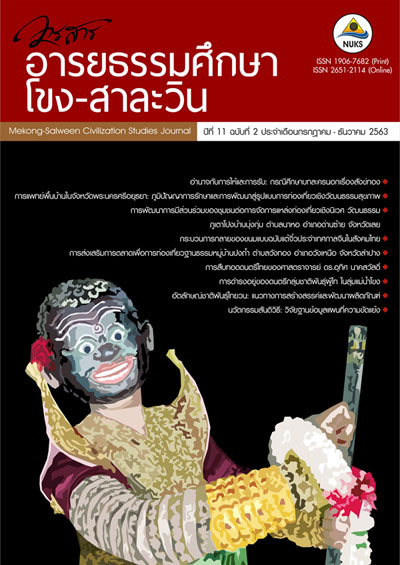The Process of Becoming Teochew Confectionery for Chinese Festivals in Thailand
Main Article Content
Abstract
The purpose of this research was to study the process of becoming the Teochew traditional confectionery for Chinese festivals in Thailand. The Teochew traditional confectionery is a part of the Chinese Teochew cuisines culture that has been widely and prevalent in Thai society for a long time. The word "confectionery" in Teochew is "Diam-sim"(点心)and "Xiao-ziah"(小食), which means dumpling-style snack and dessert. Nowadays, we usually see Teochew traditional confectionery in Thailand that is both a prevalent Chinese food in Thailand and confectionery for Chinese festivals such as Mooncake, Gu Cai Cake, Bua Loy and Yeast cake. When Teochew traditional confectionery came into the Thai society, there were many changes in the details of confectionery and became the Thai-style Teochew confectionery that has its characteristics. The researchers surveyed and collected data of Chinese festival desserts in Thailand from Thai-Chinese and Thai people living in the Chinese community in Yaowarat, Saphan Mai, Bang Khen, Worachak, Thonburi Bangkok totaling 30 families. The data, then, were analyzed to find the causes of becoming. The results of 22 Teochew confectionery for Chinese festivals in Thailand showed that there were seven topics, including 1) the names, 2) the main ingredients, 3) the process, 4) the shapes and the colours, 5) the taste, 6) the connotation, and 7) the opportunity to use (the festivals). The differences between China and Thailand in terms of resources, environment, language, values, beliefs, culture and traditions were the reasons why all of these issues were added, eliminated and changed. As a result, a new type of Teochew style was created in Thai society.
Downloads
Article Details
References
Sikkhakosol, T. (2014). Chinese festivals and offerings. Bangkok: Matichon Publishing House.
Xiao, C. (2011). The Teochew identity. Bangkok: Matichon Publishing House.
Ye, C. and Lin, L. (2010). Chaoshan folk customs. Guangzhou: Guangdong People's Publishing House.


